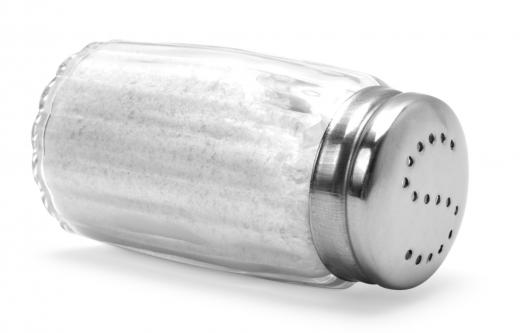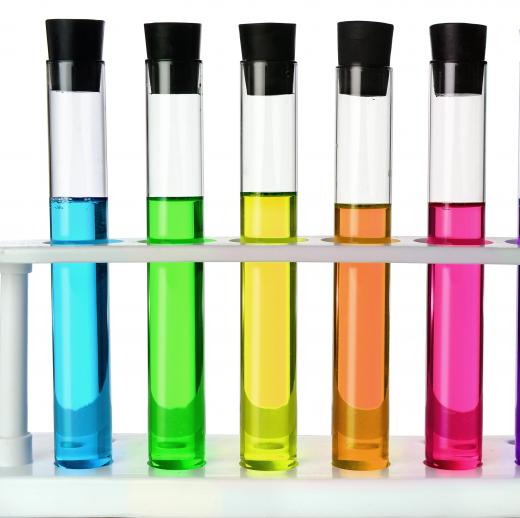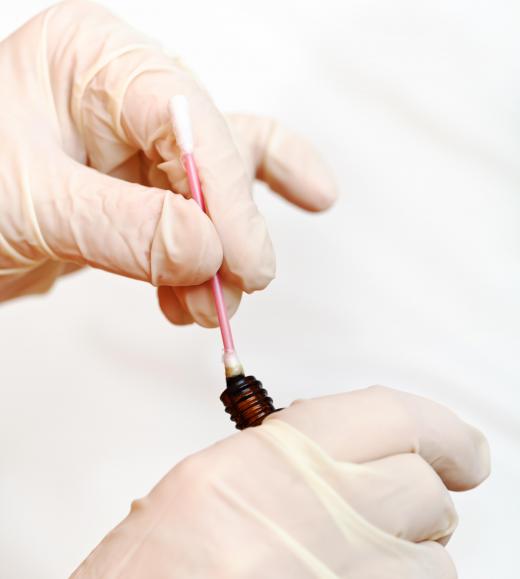What is Iodine?
 Mary McMahon
Mary McMahon
Iodine is a non-metallic chemical element with the symbol I, and atomic number 53. It is one of a group of elements known as the halogens, which also include fluorine, chlorine and bromine. Like most of the heavier elements, it is quite rare in the universe, but is found in seawater, seaweed, and in some minerals. It is an essential trace element needed for proper human nutrition, but is toxic in its elemental form. Iodine has a number of useful applications, especially in medicine, and is a common reagent used in chemistry laboratories.
Properties

Iodine is a dark gray, lustrous solid with a faintly bluish tinge. If heated, some melting occurs, but much of the substance turns directly into a vapor, which has a deep violet color. The vapor, when cooled, condenses directly back into small, solid crystals. The element is only slightly soluble in water, but dissolves easily in many organic solvents, such as ethanol, acetone, and chloroform.

Like the other halogens, this element is an oxidizing agent, which means that it will accept electrons to form compounds, but it is a less powerful oxidizer than fluorine, chlorine or bromine. In common with these elements, it will form ionic compounds with metals by accepting one electron, giving a positively charged metal ion and a negatively charged iodide ion; an example is potassium iodide. It will also form covalent compounds with other non-metals, including hydrogen and many organic substances.
Health

Iodine is required by the thyroid gland, which produces a number of important hormones that contain the element. It is also essential for proper brain development in unborn and young children. The recommended daily intake of iodine is normally measured in micrograms (mcg), or thousandths of a gram, and varies according to age, and some other factors. For example, children between one and eight years should have about 90mcg per day, and breastfeeding women, about 290. Good dietary sources of this element are fish and other seafood, seaweed, bread, cereals and dairy products.

Iodine deficiency can be a problem in some parts of the world. It can show up as goiter — a condition of the thyroid gland — and in retarded growth and poor intellectual development. People living in regions with a deficiency of this element may take a suitable supplement. The element, however, should not be ingested in its uncombined form, as it is toxic and corrosive; instead, it is usually given in the form of non-toxic iodide salts, such as potassium iodide. These are sometimes added to table salt to make iodized salt.
Uses

Many people are familiar with tincture of iodine, a brown solution of the element in alcohol, used in the field of medicine as a germicide or antiseptic. Its oxidizing properties make it effective in killing harmful microorganisms. A solution of the element in water, along with potassium iodide, which increases its solubility, is sometimes used as a disinfectant, and for the emergency purification of drinking water. In industry, one of the biggest uses of iodine is in the production of acetic acid from methanol. Other industrial uses include the production of iodized salt, and the red dye, erythrosine, which is used as a food colorant and in some colored inks.

In medicine, small amounts of a radioactive isotope of the element can be used as a tracer to check how the thyroid gland is functioning. It can also be used to treat thyroid cancer in such a way that it is absorbed by cancerous cells and not by healthy ones. Radioactive iodine is also produced by nuclear tests and accidents, and if inhaled or swallowed, it tends to accumulate in the thyroid, where it can cause damage or cancer. For this reason, in the event of an accident at a nuclear power plant, people in the immediate area may be given potassium iodide tablets: these provide a safe way of absorbing the non-radioactive form of the element, in order to block the accumulation of the radioactive form in the thyroid.
As a laboratory reagent, the element is often used in analytical chemistry. For example, it is employed in a very sensitive chemical test for starch, as the two react to form a compound with an intense dark blue color. This test can be used to detect very small quantities of starch. Unsaturated fats can combine with amounts of iodine that are proportional to the degree of unsaturation: the less saturated the fat, the more of the element it will use up. This forms the basis of the iodine value that can be given to fats.
Manufacture
The element was first prepared in 1811 by Bernard Courtois, when he treated seaweed ash with sulfuric acid. He obtained a purple vapor, which condensed into crystals. Today, most iodine comes from brine, which contains iodides, or from sodium iodate, which is present in a type of calcium carbonate rock called caliche.
AS FEATURED ON:
AS FEATURED ON:
















Discussion Comments
Thanks! this helped so much (element project) at first i wanted phosphorus, but glad i chose iodine instead.
why is iodine toxic?
tons of facts. thanks a lot.
Thanks wisenerd! super helpful.
thanks. this helped me a lot on my science fair project.
thanks! Love this site - so handy!
What foods are highest in iodine?
thanks this was helpful.
this did help me, thank you :)
you people are geeks though lol...
Adults need about 150mcg of iodine in their daily diet. We mostly get it with table salt, but a serving of fish, or two servings of yogurt will meet daily needs too.
Post your comments